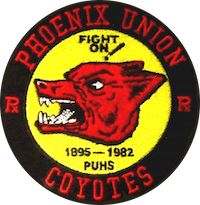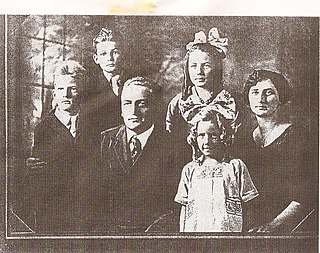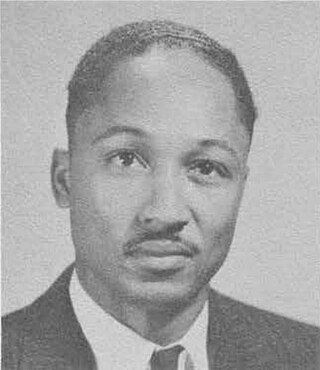
Phoenix is the capital and most populous city of the U.S. state of Arizona, with 1,608,139 residents as of 2020. It is the fifth-most populous city in the United States and the most populous state capital in the country.

Litchfield Park is a city in Maricopa County, Arizona, United States. It is located 19 miles (31 km) west of Phoenix. As of the 2020 census, the population of the city was 6,847, up from 5,476 in 2010.

Tempe is a city in Maricopa County, Arizona, United States, with the Census Bureau reporting a 2020 population of 180,587. The city is named after the Vale of Tempe in Greece. Tempe is located in the East Valley section of metropolitan Phoenix; it is bordered by Phoenix and Guadalupe on the west, Scottsdale and the Salt River Pima–Maricopa Indian Community on the north, Chandler on the south, and Mesa on the east. Tempe is also the location of the main campus of Arizona State University.

Downtown Phoenix is the central business district (CBD) of the City of Phoenix, Arizona, United States. It is in the heart of the Phoenix metropolitan area or Valley of the Sun. Phoenix, being the county seat of Maricopa County and the capital of Arizona, serves as the center of politics, justice and government on the local, state and federal levels. The area is a major center of employment for the region, with many financial, legal, and other national and international corporations housed in a variety of skyscrapers. Major arts and cultural institutions also call the area home. Downtown Phoenix is a center of major league sports activities, live concert events, and is an equally prominent center of banking and finance in Arizona. Regional headquarters for several major banks, including JP Morgan Chase, Wells Fargo, US Bank, Bank of America, Compass Bank and Midfirst Bank are all located within or close proximity to the area.

The Phoenix Union High School District is a high school-only school district in Phoenix, Arizona, United States. It is one of five high school-only districts in the Phoenix area.

North High School is a high school that forms part of the Phoenix Union High School District in Phoenix, Arizona.
Enid Public Schools is a public school district located in Enid, Oklahoma, USA. The school district had an enrollment of 7,540 students in September 2012.

Lincoln Johnson Ragsdale Sr. was an influential leader in the Phoenix-area Civil Rights Movement. Known for his outspokenness, Ragsdale was instrumental in various reform efforts in the Valley, including voting rights and the desegregation of schools, neighborhoods, and public accommodations.

Phoenix Union High School (PUHS) was a high school that was part of the Phoenix Union High School District in downtown Phoenix, Arizona, one of five high school-only school districts in the Phoenix area. Founded in 1895 and closed in 1992, the school consisted of numerous buildings on a campus which by 1928 consisted of 18 acres.
The Murphy Elementary School District 21 is an elementary school district in Phoenix, Arizona. It operates three K-8 schools and previously operated a fourth.
The following is a timeline of the history of the city of Phoenix, Arizona, United States.

The following is a timeline of the history of the area which today comprises the U.S. state of Arizona. Situated in the desert southwest, for millennia the area was home to a series of Pre-Columbian peoples. By 1 AD, the dominant groups in the area were the Hohokam, the Mogollon, and the Ancestral Puebloans. The Hohokam dominated the center of the area which is now Arizona, the Mogollon the southeast, and the Puebloans the north and northeast. As these cultures disappeared between 1000 and 1400 AD, other Indian groups settled in Arizona. These tribes included the Navajo, Apache, Southern Paiute, Hopi, Yavapai, Akimel O'odham, and the Tohono O'odham.

Frederick Christian Struckmeyer Jr. was a justice of the Supreme Court of Arizona from January 3, 1955, to January 19, 1982. He served as chief justice of the court on four occasions.

Greenwood Memory Lawn Mortuary & Cemetery is the official name given to a cemetery located at 2300 West Van Buren Street in Phoenix, Arizona owned by Dignity Memorial. The cemetery, which resulted as a merger of two historical cemeteries, Greenwood Memorial Park and Memory Lawn Memorial Park, is the final resting place of various notable former residents of Arizona. Pioneers, governors, congressman, government officials, journalists, race car drivers, soldiers, actors and actresses are among the many notable decedents who are interred in the cemetery.
Dunbar School was a segregated middle school in Tucson, Arizona which closed as an integrated school in 1978.
Dunbar Elementary School is an elementary school in Phoenix, Arizona that was once segregated.

Carver Court is a historic housing development located at Foundry Street and Brooks Lane near Coatesville in Caln Township, Chester County, Pennsylvania. Built in 1944 in the International Style, Carver Court is important to understanding the African American experience in Coatesville. The development was added to the National Register of Historic Places in 2016.

Calvin C. Goode was a Phoenix accountant, city councilman, vice mayor, and civil rights leader. Goode was the longest-serving councilman in Phoenix history, serving 11 consecutive terms totaling 22 years of service. The Calvin C. Goode municipal building and the annual Phoenix Calvin C. Goode Lifetime Achievement Award were named in his honor.
Betty Fairfax was an educator, counselor, and philanthropist with the Phoenix, Arizona high school district.


















